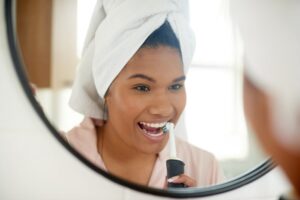Your toothbrush is one of the most important tools for maintaining good oral hygiene. It helps to remove plaque and bacteria from your teeth and gums, preventing tooth decay and gum disease. But did you know that the health of your toothbrush is just as important as how you use it? If you store your toothbrush incorrectly, it could harbor harmful bacteria.
Rather than cleaning your teeth, it could negatively affect your oral health. Therefore, knowing more about toothbrush health and how to use it properly is essential.

Why Your Toothbrush is Important
Your toothbrush is your primary tool for removing plaque and bacteria from your teeth and gums. It helps to prevent tooth decay, gum disease, and other oral health problems. Therefore, a clean and effective toothbrush is essential for maintaining good oral hygiene.
How to Keep Your Toothbrush Clean
Keeping your toothbrush clean is vital to prevent the buildup of bacteria and germs.
After brushing your teeth, rinse your toothbrush thoroughly with water. This helps to remove any remaining toothpaste. Additionally, rinsing your toothbrush removes any remaining plaque or food debris. If you leave this on your toothbrush, it could foster the growth of harmful bacteria.
To store your toothbrush, you should leave it in an upright position in a dry place. In addition, you should avoid storing it in a closed container, as this can promote the growth of bacteria.
Most dentists recommend replacing your toothbrush every three to four months or when the bristles become frayed or worn. A worn toothbrush will be less effective at removing plaque and bacteria.
Finally, you should avoid sharing your toothbrush with others. This can transfer bacteria and germs between people.
What Can Go Wrong with Your Toothbrush
A few things can go wrong with your toothbrush that can impact its effectiveness at removing plaque and bacteria.
Worn Bristles
Over time, the bristles on your toothbrush can become frayed or worn, which makes it less effective at removing plaque and bacteria. This is why you should replace your toothbrush every three to four months.
Contamination
If your toothbrush is not stored properly or is shared with others, it can become contaminated with bacteria and germs. Brushing your teeth with a bacteria-filled toothbrush can increase your chances of gum disease or other dental issues.
Damage
Dropping or using your toothbrush with too much force can damage the bristles, making it less effective at cleaning your teeth.
How to Properly Brush Your Teeth
Using the right technique when brushing your teeth removes plaque and bacteria. For example, a soft-bristled toothbrush is the best fit for most people. A hard-bristled toothbrush can cause damage to the enamel and your gums. This can increase your risk of developing cavities or receding gums.
When you brush your teeth, you should hold your toothbrush at a 45-degree angle to your gums. This will allow the bristles to reach underneath your gum line, helping remove harmful plaque. Additionally, you should brush in a gentle, circular motion. This technique helps efficiently remove plaque and reduce damage to your gums.
